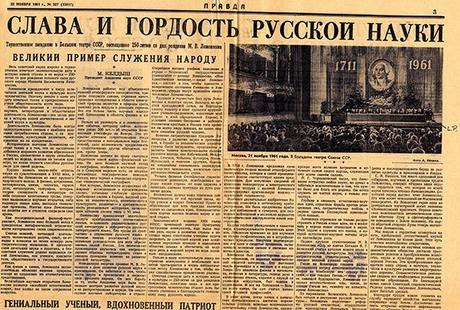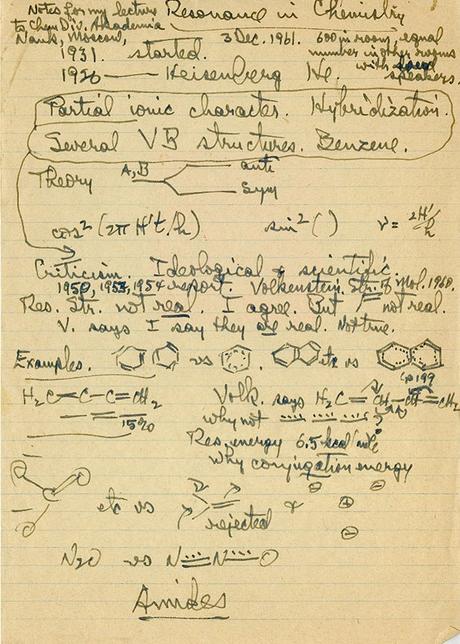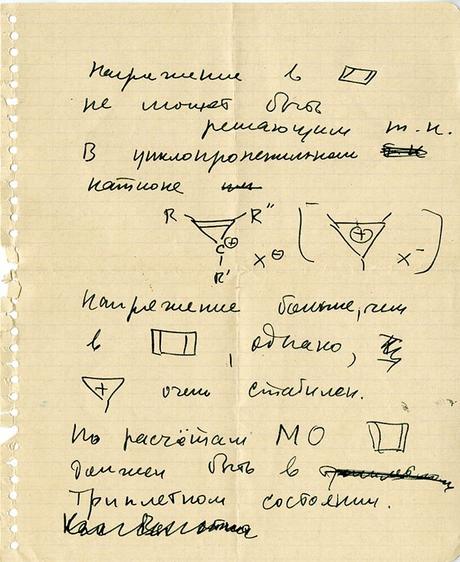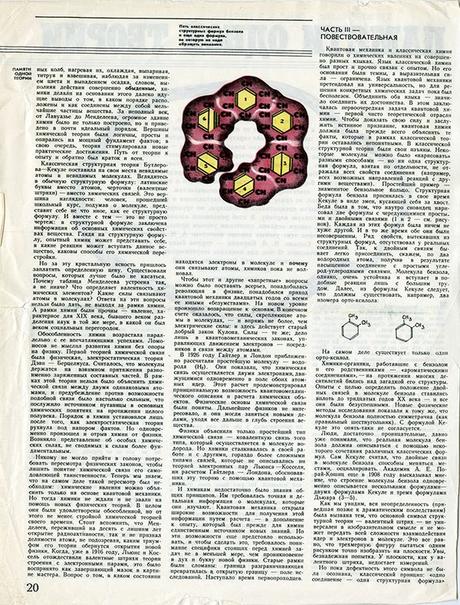 “Glory and Pride of Russian Science,” Pravda, November 22, 1961. Note Pauling’s annotation at far right.
“Glory and Pride of Russian Science,” Pravda, November 22, 1961. Note Pauling’s annotation at far right.[Part 6 of 7]
After the death of Joseph Stalin in 1953, scientists in the Soviet Union began to decrease the intensity of their attacks on Linus Pauling and his theory of resonance. This process played out for at least another ten years, during which time the combatants’ points of emphasis gradually shifted.
Instead of arguing against the theory because it opposed Soviet ideology, Pauling’s critics now focused on his failure to acknowledge the work of Russian scientists whom they argued were influential to his breakthrough. This difference marked a monumental deviation from the scientists’ earlier platform for opposition. Before, the Soviets put forth a blanket rejection of resonance as an idea, and thus abandoned its use in developing their scientific work. However, post-Stalin, the Soviets tacitly began to recognize the utility of resonance while still arguing for credit that they felt was owed to luminaries of their past.
Pauling also began to soften his rhetoric in defending his theory, perhaps in part because of the complex nature of his relationship with the Soviet Union. The years of the resonance controversy coincided with stateside accusations that Pauling was a communist and a Soviet sympathizer. During this period, Pauling had also been very public in urging the Soviets to slow down the pace of their atomic weapons development and testing. In the midst of these heady issues, the battle to defend resonance was perhaps just not quite so pressing, and it was in this context that the final phase of the resonance theory controversy took place.

The last chapter of the dispute began when Pauling gave a speech on resonance in Moscow, a talk that would have been unimaginable during Stalin’s lifetime. Delivered on December 3, 1961, Pauling made his remarks to the chemistry division of the Soviet Academy of Sciences.
At his hosts’ urging, Pauling began by praising a Russian chemist, Mikhail Vasilyevich Lomonosov (1711-1765), for first theorizing that the properties of chemicals are a result of “their structure as aggregates of atoms.” Pauling’s offering of acclaim was not without calculation however, in that he also argued that that Lomonsov was a free thinker, and that he had used his “imaginative effort” and “high originality” to develop his ideas.
Perhaps most importantly, Pauling stressed that Lomonosov’s ideas were based on conceptual findings, not ideological doctrine. In this, Pauling was clearly trying to emphasize the ways in which Russian science had differed from the more contemporary Soviet approach, with old masters like Lomonosov developing their thinking on the basis of experimental data. By using Lomonosov as an anchor for this argument, Pauling made clear throughout his speech his continuing objection to the Soviet ideological attack on his theory.

The controversy had been brewing for well over a decade by the time Pauling gave his speech, so it would stand to reason that many in attendance still doubted the validity of resonance theory. And indeed, handwritten questions offered to Pauling at the conclusion of his lecture ranged from outright denial of resonance theory to asking whether or not molecular orbital theory or other explanations could be used instead to understand chemical structures and their properties.
Generally speaking though, these audience-generated questions were not ideologically based, perhaps because Pauling had deliberately chosen at the outset to “ignore the criticism [of his theory] on ideological grounds” and instead devoted most of his speech to systematically arguing in support of the science. The case that he made was clear and straightforward, but also imbued with undertones of sadness. Specifically, Pauling mourned the loss of scientific contributions that could have been made had the Soviet establishment bought in to resonance from the beginning. This sentiment comes across most acutely in the talk when Pauling laments that there is not a single “textbook of chemistry published by any Soviet scientist during the past ten years in which the theory of resonance is presented in a reasonably satisfactory way,” an omission that would guarantee that future Soviet students would be “seriously hampered.”
Pauling’s Moscow lecture signaled a clear shift in the arc of the controversy. Though still critical of Soviet science and its lack of fundamental integration of resonance theory, Pauling was at least willing to visit the Soviet Union and concede a small piece of intellectual ground. In the wake of these actions, the controversy moved into its final, least aggressive form.
Publications authored in the months following Pauling’s visit increasingly came to show that the Soviets no longer rejected resonance, but did want to be included in the story of its discovery. One notable example was a May 1962 article by G.M. Bykov titled “The Origin of the Theory of Chemical Structure.” The piece was written in English, a clear indication of its intended audience, and argued that all chemical structure theory should be based on the work of Russian scientists. It is “[t]rue,” Bykov writes, that Russian scientists such as A.M. Butlerov “did not develop and did not always support” other ideas about chemical structures. But for Bykov and his colleagues, Butlerov was “the founder of the theory of chemical structures” and “the establishment of a correct conception of chemical atoms” would necessarily be based on his ideas.

Responses of this sort allowed the Soviet academy to protect national pride while simultaneously updating their practices to align with the rest of the world. The shift in rhetoric also helped to end the extreme animosity that had been directed towards Pauling and, by the 1970s, the Soviets had essentially retracted any ideological objection to resonance theory. In fact, in 1972 the popular Soviet science magazine, Znanie Sila (“Knowledge is Power”) published a retrospective titled “In the memory of a theory” that used interviews with M.E. Diatkina to recount the resonance story and its importance in the world of chemical structures.
By the 1970s, Pauling and the Soviets had effectively ended their feud with both sides having offered a bit of a compromise. Even though Pauling never fully acknowledged Russian science as directly influencing his theory, he did concede for the records that Russians had developed some early ideas regarding the structure of chemicals. For their part, the Soviets lessened the intensity and direction of their objections and gradually adopted resonance theory into their modeling.
Despite this thawing of relations, other scientists and the public at large continued to weigh in on the controversy, as they had done since its genesis. The story of these outside perspectives, and Pauling’s responses to them, will be the subject of our final post in this series.
